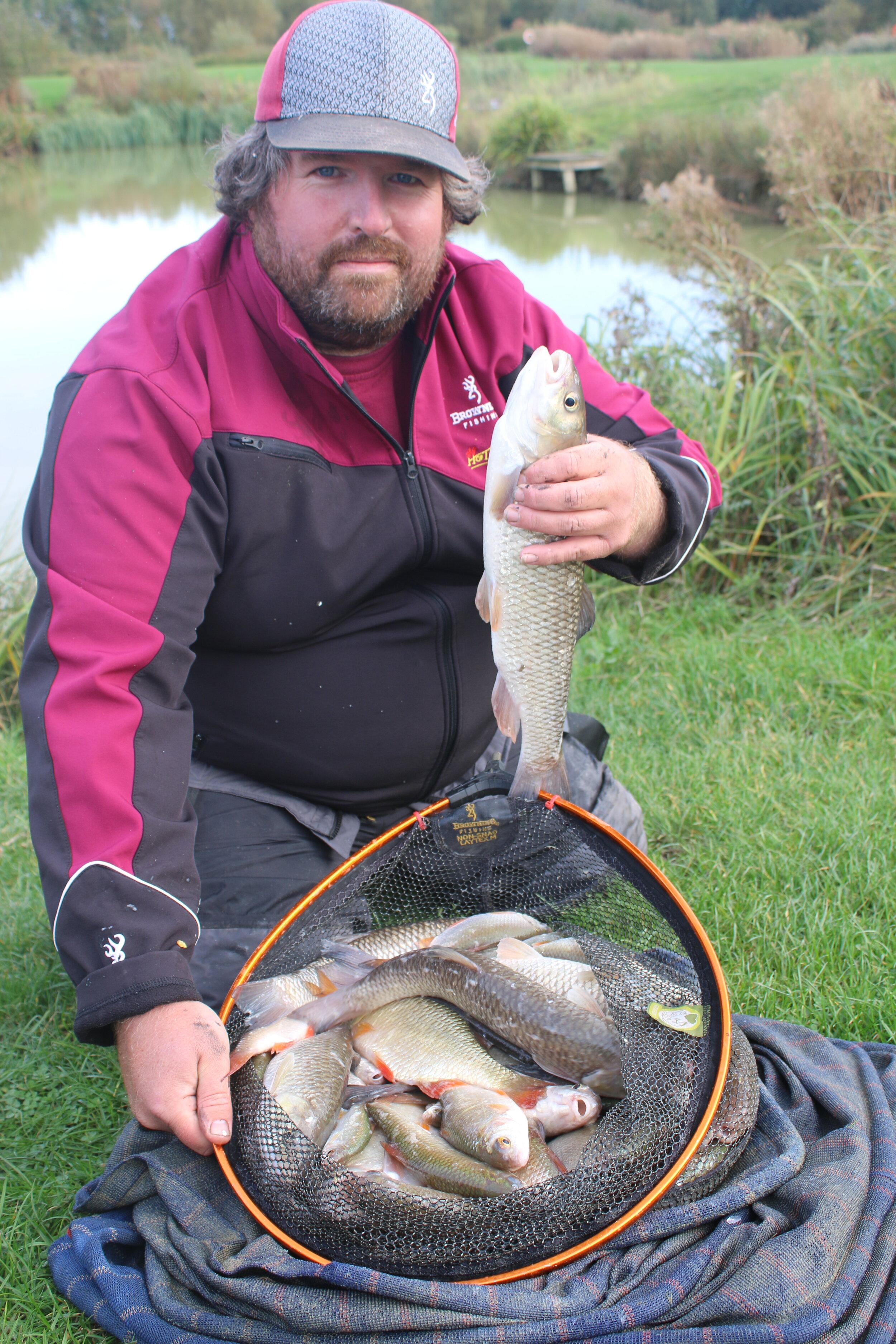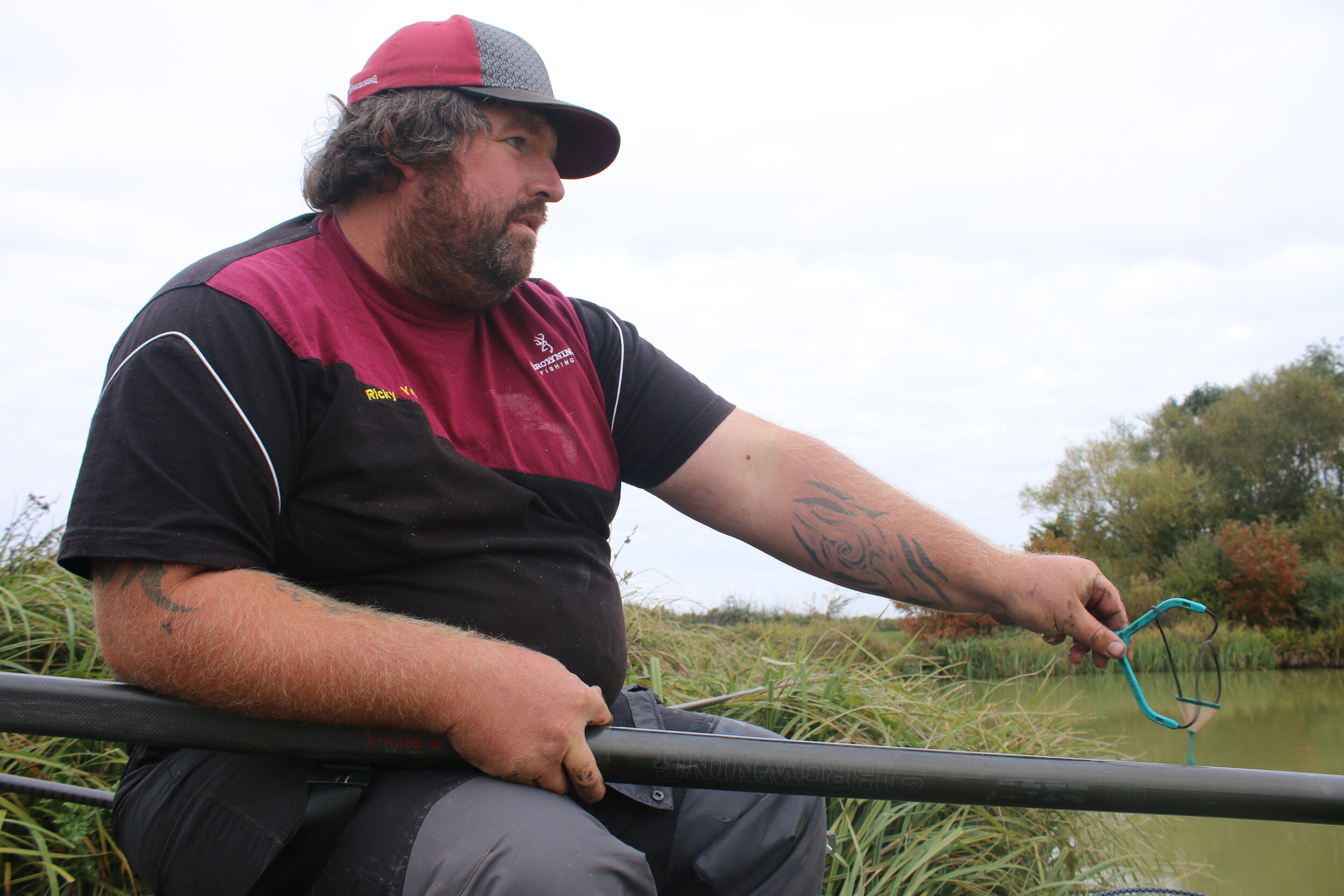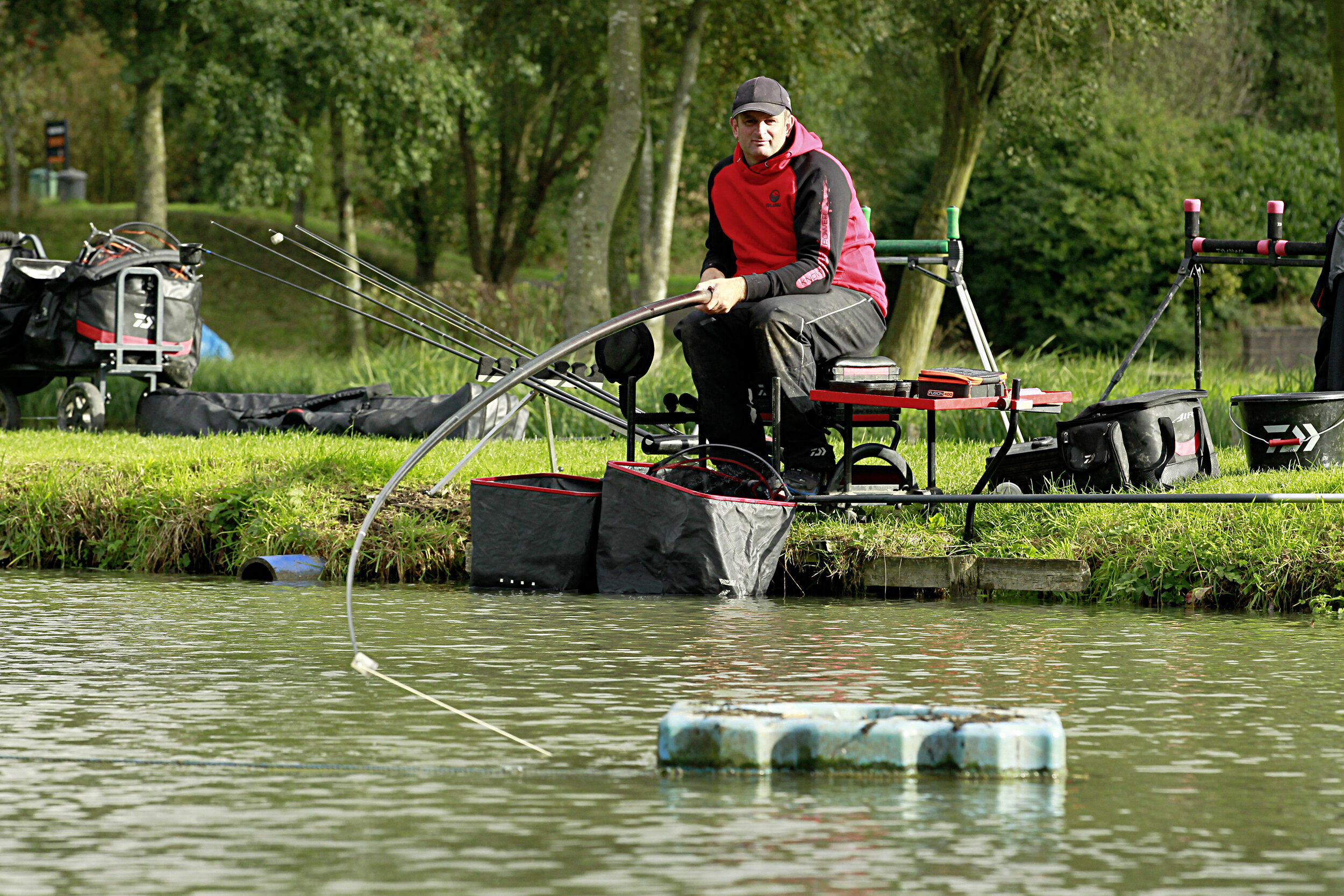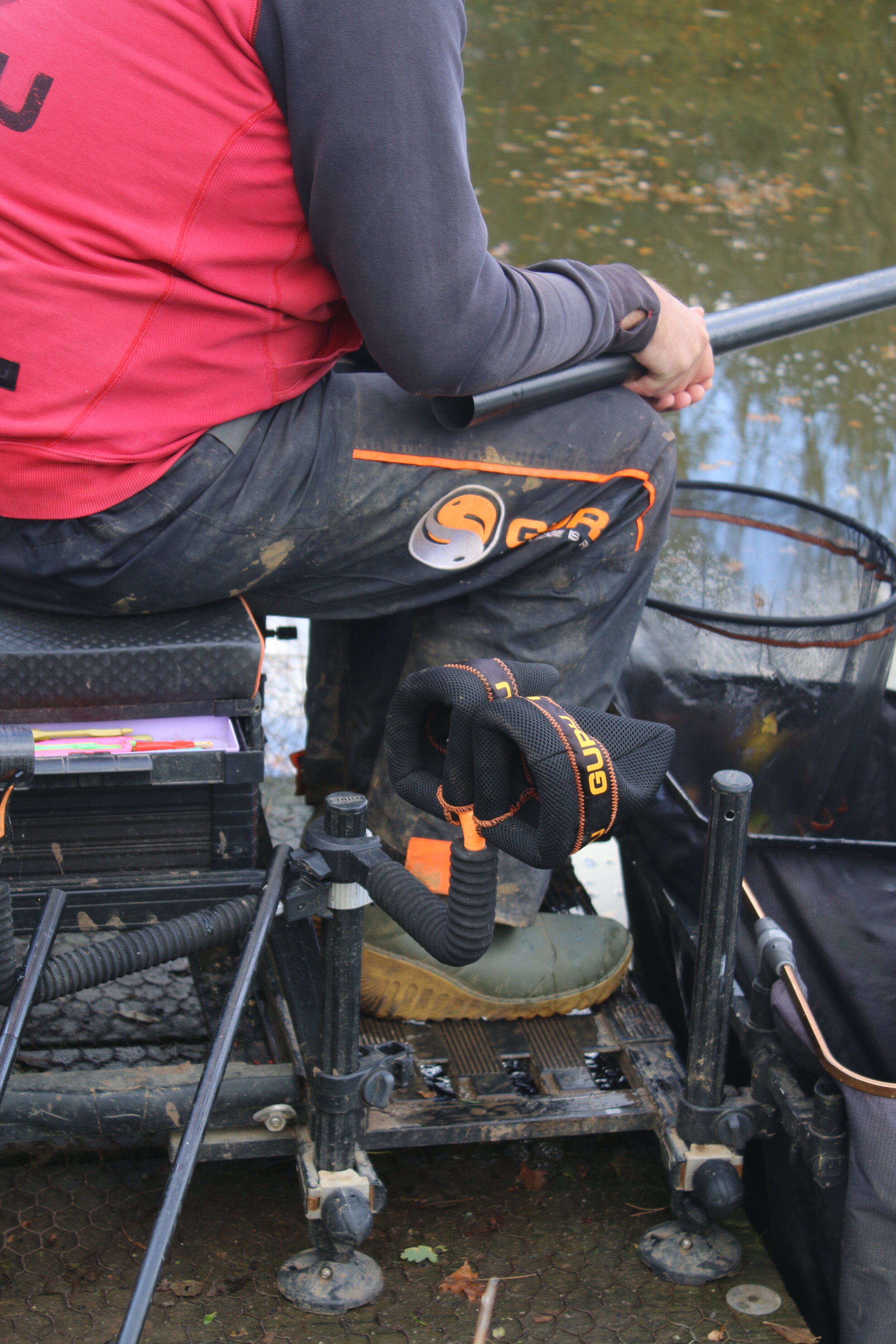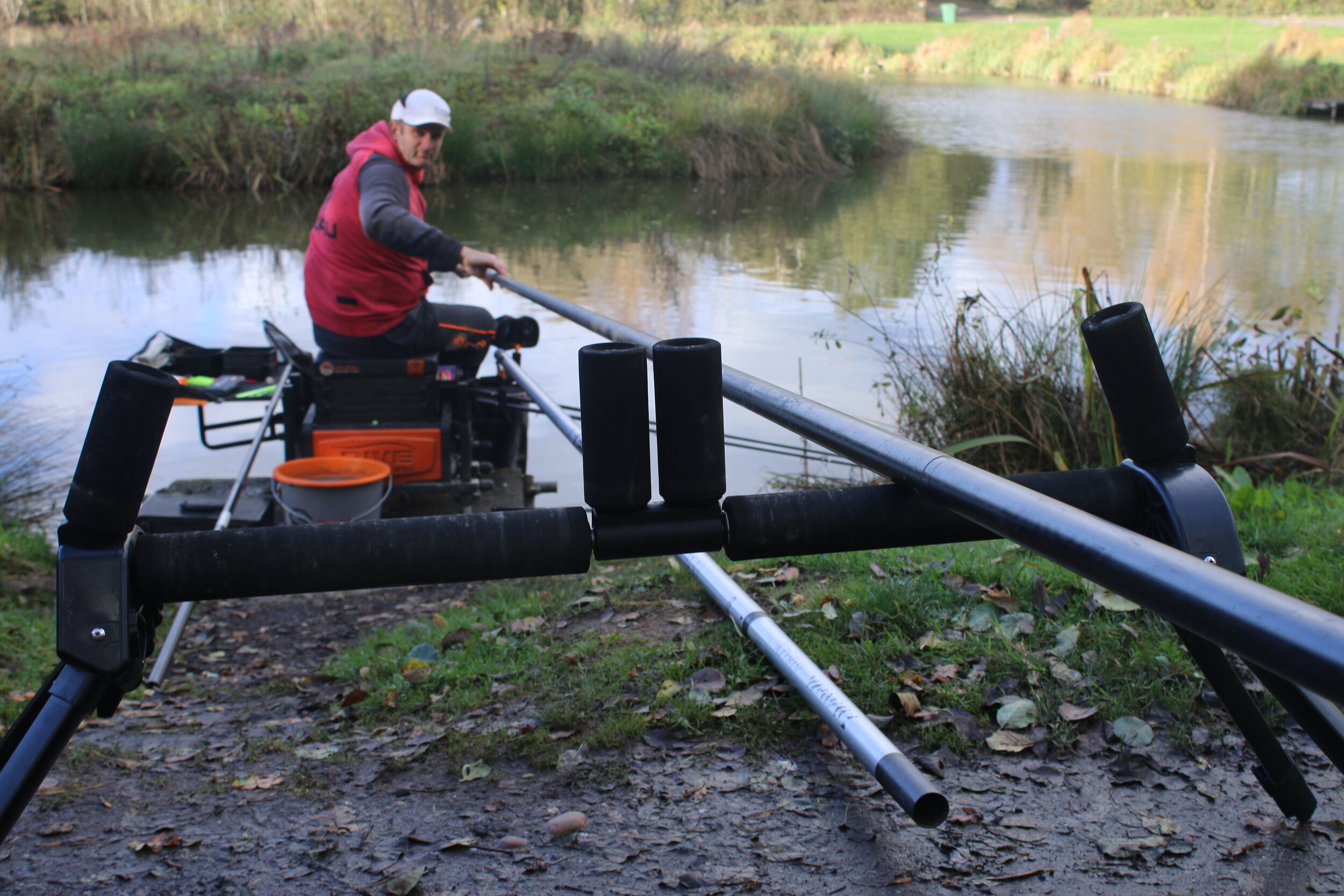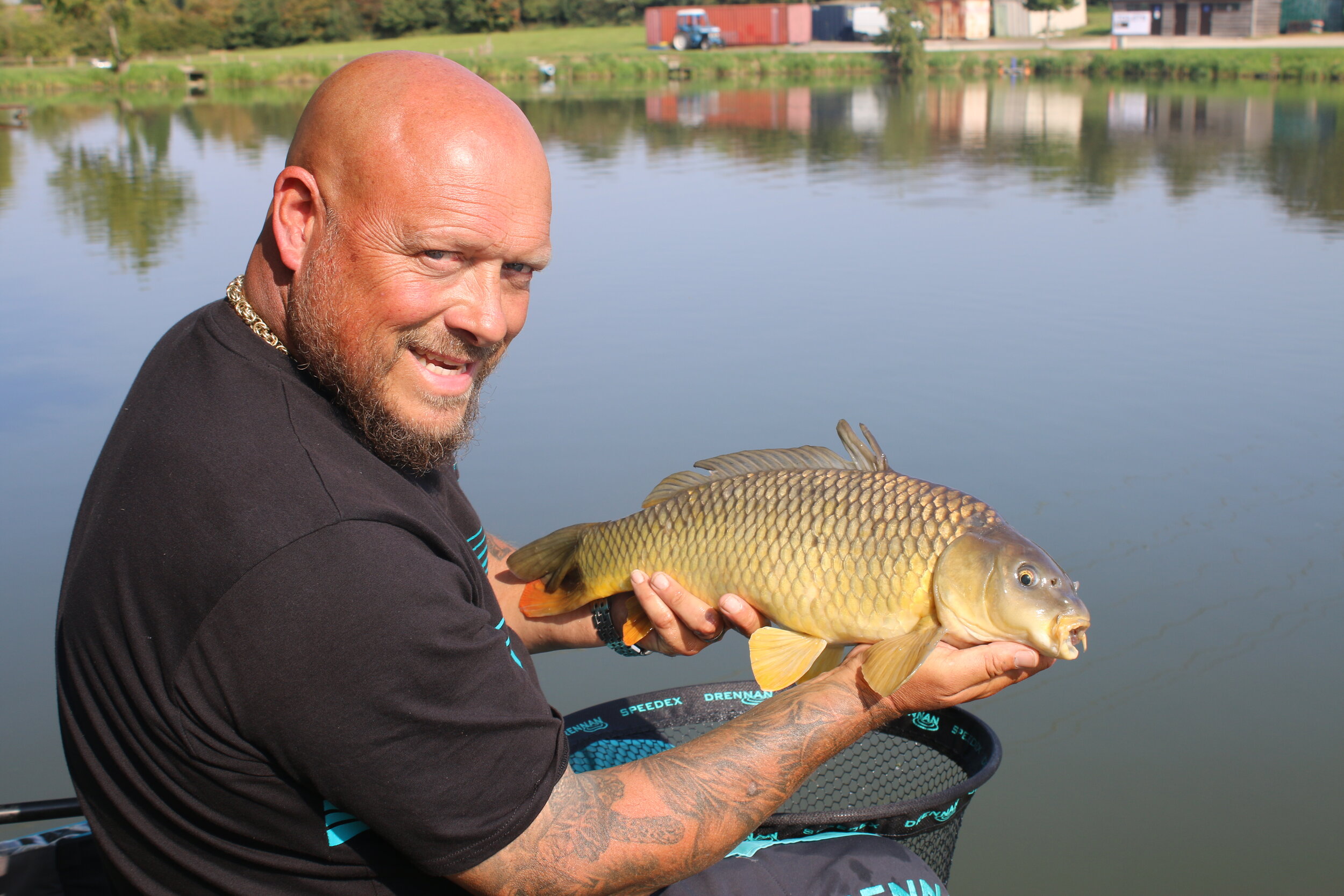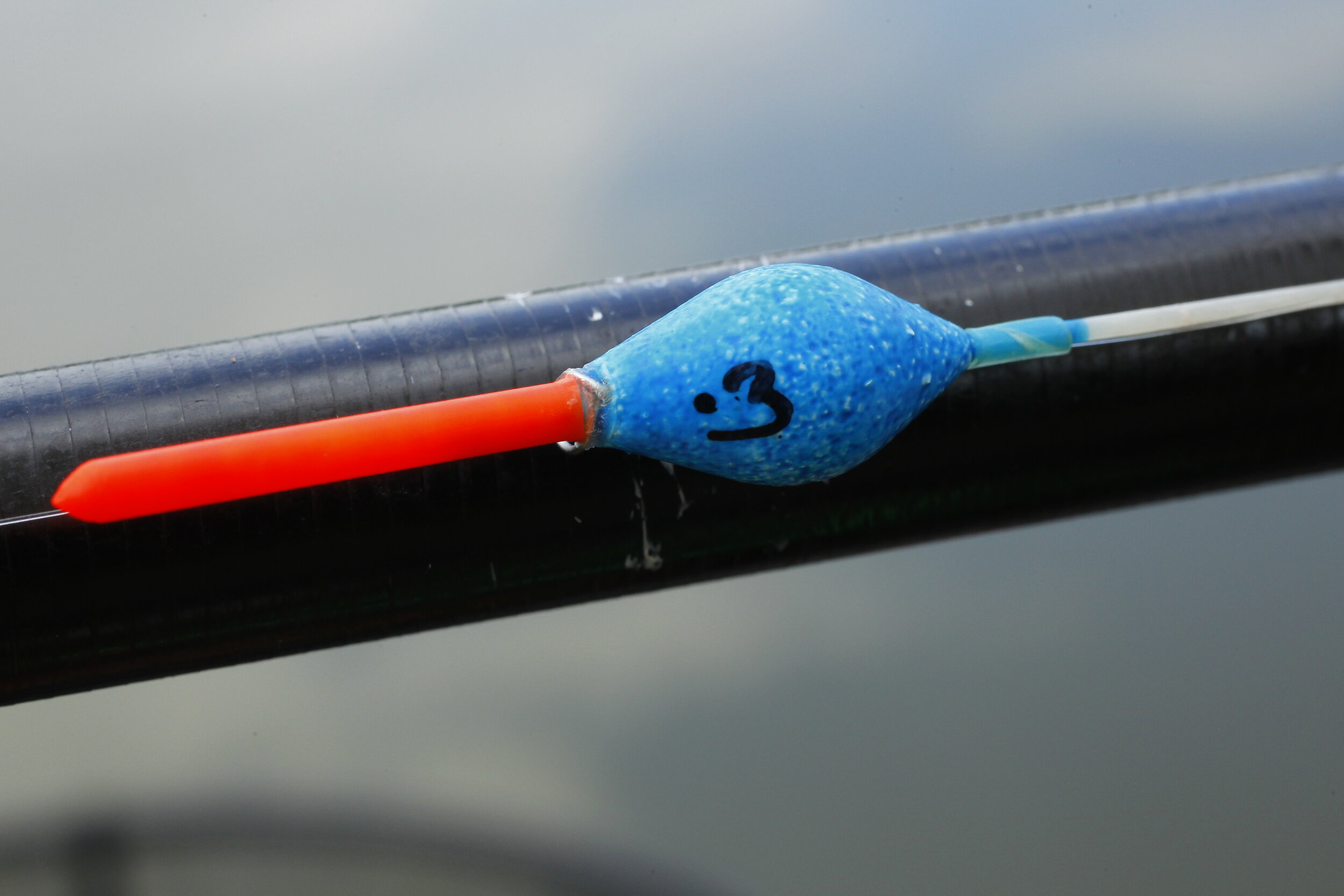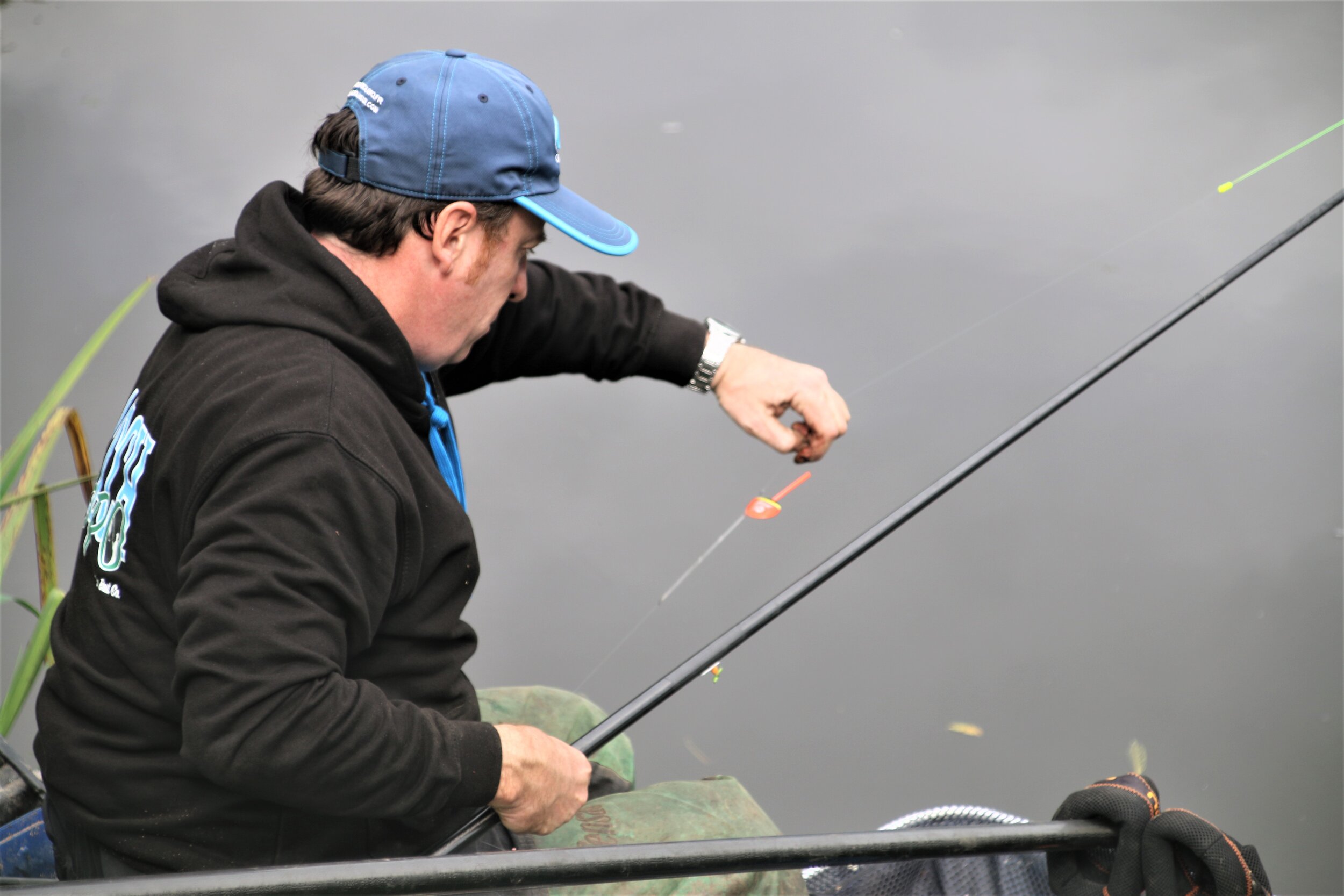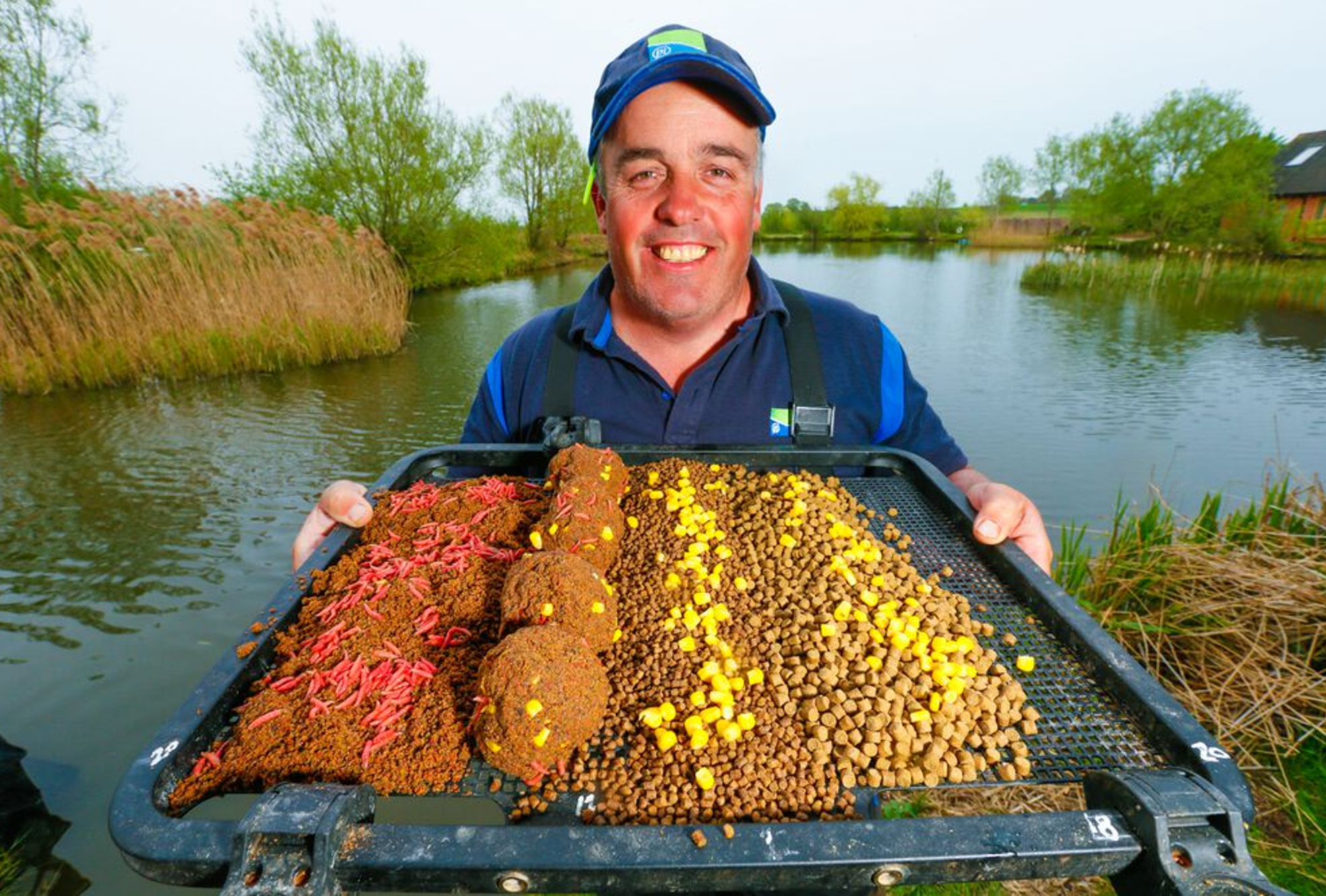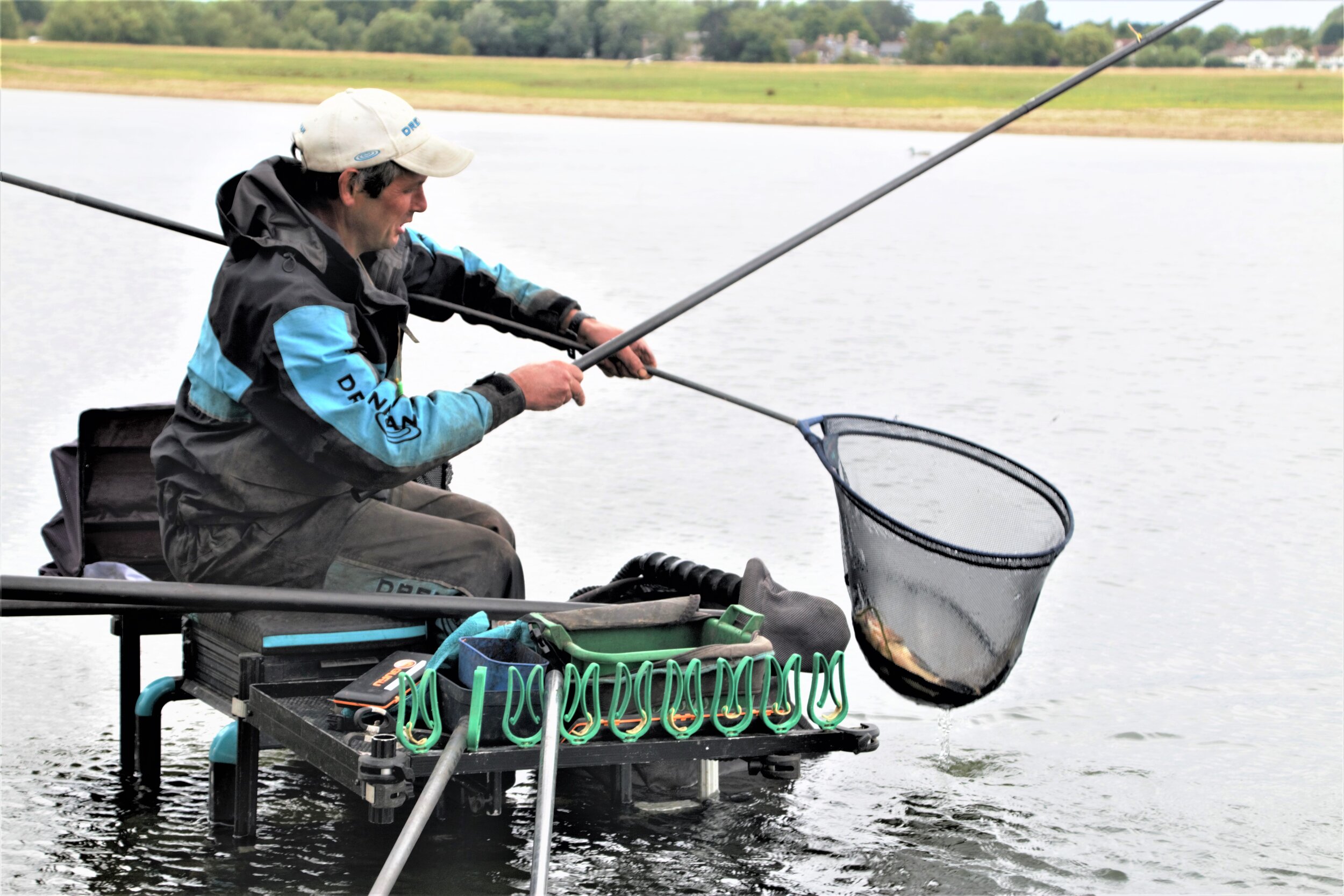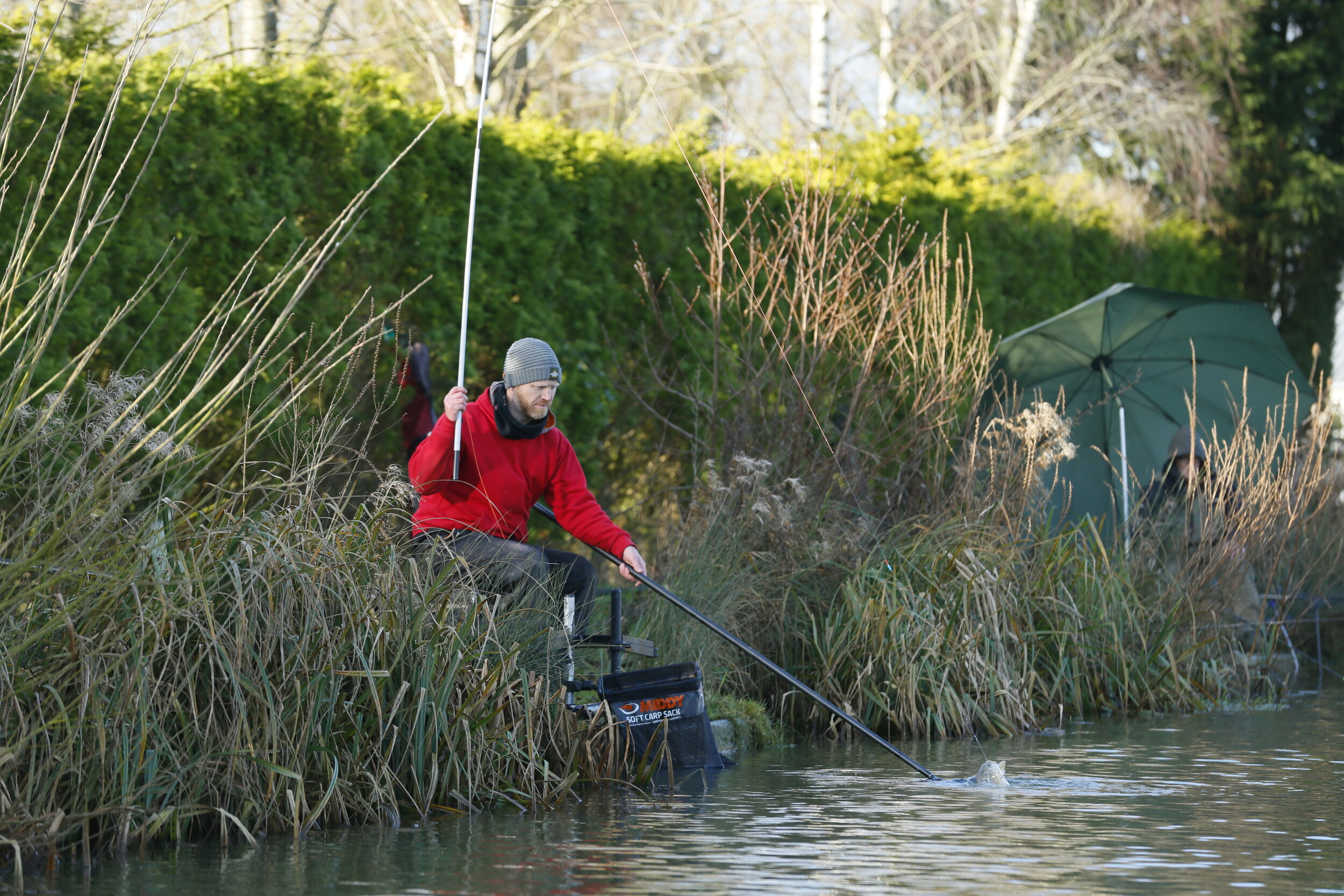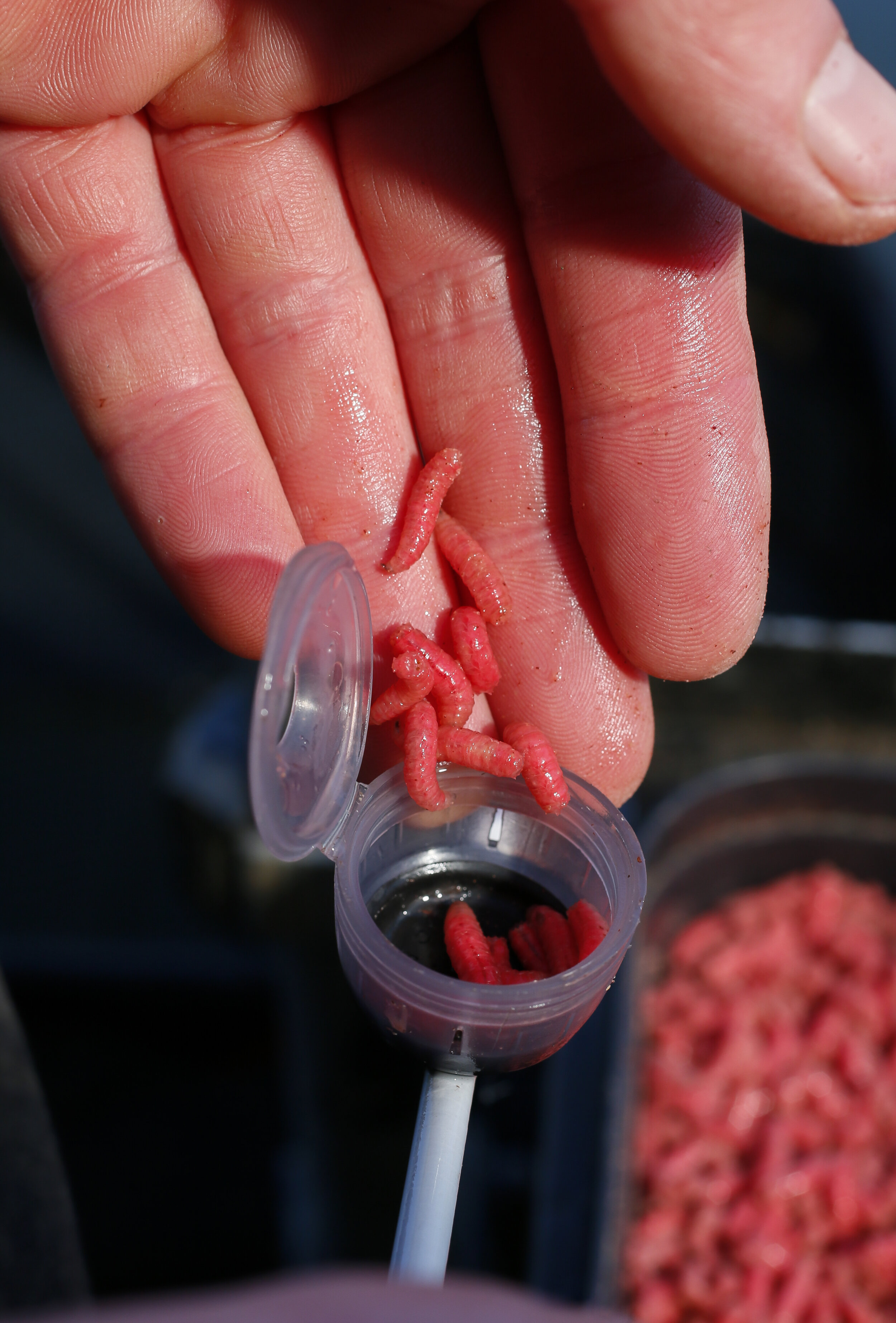Commercial Fishing Tips | Six tips to shallow up for silvers - Ricky Young
As long as the temperatures overnight and in the day stay settled, with no big drops, I’ll put my money on catching a big net of quality silvers by fishing off bottom, sometimes even properly shallow.
Fishing shallow can catch you quality nets of silvers
Here’s some tips to help you do the same…
GO FOR A LIGHT ELASTIC
Even if you hook a rogue carp, you can get it out using light elastic. The Browning Microbore orange grade I use is perfect – soft enough to land roach and skimmers without hook-pulls, but you can land a carp with a side-puller kit.
Big fish can be landed on light elastics
GREAT PRESENTATION
A light float allows the bait to fall through the water slowly and find the bigger roach. A homemade slim-bodied 0.2g float taking seven or eight No10 shot strung in the bottom half of the rig will get the job done.
A light float encourages a slow fall of the hookbait through the water
USE GROUNDBAIT
I’ll pot in three large balls of groundbait. This attracts and focuses the fish in a spot over which I can then fire casters. My mix is a split of Browning Black Roach, Quick Skimmer and Formula Fish.
Pot in groundbait to draw the fish in from the off
SWITCH TO MAGGOTS
Casters are always my choice for silverfish, but they can sometimes be too selective. Maggots are the great fall-back bait that can get a peg going again when it seems to have slowed up.
Maggots are a great change bait if bites slow down on casters
FEED A SECOND LINE
You won’t plunder one line all day, as the fish will eventually back off. This is where I have a second swim on the go, to target big roach and skimmers. I put this in at 6m but off to one side, and will only fish here on the bottom.
Feed another line to with to when bites slow up
FEED WITH A CATTY
While the weather remains mild, the fish will still be active. To catch off bottom, you need to keep loosefeeding casters. The regime is 10 casters fired in every time I drop the rig in and every 60 seconds when I’m fishing the close-in line.
Keep the feed going in
Pole Fishing Tips | Set up to fish the long pole properly - Steve Ringer
WE ALL want to start fishing as soon as we can when arriving at a lake or river, but this rush to get set up can be detrimental for later in the session, especially when fishing the long pole. If you take your time to get organised properly, you’ll be more efficient and catch more fish!
This definitely applies to the long pole, a method that requires as much thought to how your seatbox and pole rollers are set up as it does to the rigs and baits on the other end. Fish with an uneven box that’s set too low down to the ground and it’s hard work.
Likewise, have your pole roller in the wrong position or at the wrong height and unshipping will become a real chore. Worse than that, you could end up breaking your pole. Getting set up properly is a good habit to get into and when done correctly, will allow you to become more machine-like with your fishing, working smoothly with everything in place and to hand.
If you take your time to get organised properly, you’ll be more efficient and catch more fish!
Get level!
Not getting your box level is a recipe for disaster and will give you backache! Make sure your feet are flat on the footplate and sit with your legs slightly to one side, resting the pole across your thighs. Your elbow will then rest on top of the pole.
Not getting your box level is a recipe for disaster and will give you backache!
How many rollers?
On flat banks, I’d use one roller for fishing up to 11m and two past this. If the bank behind you is steep, you can get away with one and use the bank as a second. I like to extend my roller legs fully so my rig is always in the water when shipping.
On flat banks, I’d use one roller for fishing up to 11m and two past this
Side tray height
Fix your side tray too low and you’ll always be reaching for feed or hookbaits, which will put you off balance. I want to simply reach off to one side and pick up bait or a catapult without taking my eyes off the float.
Fix your side tray too low and you’ll always be reaching for feed or hookbaits
Bump bars
These seem a good idea as they leave your hands free to feed. In windy weather they’re great, taking the strain of battling with 13m of pole off your back and also keeping the rig dead still. For pole fishing beginners, they’re a must.
For pole fishing beginners, bump bars are a must.
Commercial Fishing Tips | Time to get the most from natural baits - Ian Chadburn
In an age of pellets, paste and wafters on commercials, it’s easy to leave good old maggots and casters in the tackle shop fridges for the river and canal anglers. After all, maggots only attract little fish – and who wants to catch those?
As we start to experience colder weather, the answer to this question should be ‘everyone’. We can all recall days out when the carp haven’t played ball and you come off the bank with little to show for your efforts using baits like pellets.
Natural baits will still catch plenty of carp
As the weather and water cool, fish don’t feed as strongly or for long periods of time. This means you’re left with long gaps between bites, gaps that can easily be filled by adopting a natural bait approach with maggots and casters.
There’s not a fish swimming that won’t eat maggots, so you can never be sure what you’re going to hook when the float goes under. The natural route shouldn’t be limited to just maggots and casters either – worms and hemp also work.
Slow periods can be made busy with natural baits
Use groundbait
Keep one line reserved for big fish, feeding it with groundbait and corn. Depending on the depth, feed the groundbait either loose in shallow water with a silty bottom, or as a ball in deeper pegs with a hard bottom.
Groundbait should be fed on the big fish line
Catch them all
While you let the big-fish lines settle, fish for bites with maggots. These could be from a 2oz roach to a 10lb carp just 5m or 6m out. Throwing in around half-a-dozen maggots every drop-in will keep a steady stream of bait going in.
Keep feeding maggots in close to keep action coming
Little & large floats
On the maggot line, a slim float taking around 0.4g will let you fish with the bait falling through the water. On the long pole, big-fish agenda, this is upped to a 0.6g rugby ball-shaped pattern for stability.
Have several rigs ready
The baits to use
All you need are maggots, casters, worms, hemp and corn. Maggots, casters and worms are the main hookbaits, hemp and corn coming into play as feed. A couple of pints of each will be ample.
A selection of natural baits
Fish the margins
Until the first frosts strike, the margins are a great place to catch later in the day. Forget about finding 12ins of water... 2ft 6ins-3ft is what you’re after. Depth is more crucial than cover from reeds and lily pads.
The margins will still produce until the first frosts
Use your time wisely
Treat the big-fish lines as somewhere to have a look at now and then. The maggot line will be where you should spend most of your time. A maximum of 10 minutes is all you need on the big-fish lines.
Don’t spend too long waiting for bites on the big fish line
Commercial Fishing Tips | How to hit more bites from F1s - Reece Hearn
I catch a lot of F1s in the cooler weather just as the bait settles, and in clear water I think that the fish actually watch the bait fall, so how you present the hookbait will go a long way to deciding many you actually hook.
I try to bomb the rig down towards the bottom as normal but then stop the fall with about 12ins of the rig sticking out of the water to let the rig straighten up.
I then slowly lower in the rest of the rig to give the bait a super-slow fall in the bottom foot of water.
I’ll also lift and drop the rig the same distance when fishing to keep the pellet falling in front of the fish. Try this and you’ll hit more bites!
F1s will watch the hookbait fall
Canal Fishing Tips | Should you loosefeed over groundbait? - Matt Godfrey
On the deep shipping canals of Yorkshire that I fish, loosefeeding over the top of groundbait actually defeats the point of what I’m trying to achieve. I want the fish to be firmly on the bottom, feeding on the groundbait and giving me a focal point over which to put my rig.
Firing in casters or maggots runs the risk of spreading the fish over a wider area and even coming off bottom, so I wouldn’t use a catapult at all. Instead, I’ll cup in two to four balls of groundbait, the amount depending on how many fish I feel are in the area and how good the peg is, topping up with a ball the size of a large walnut when bites fade or I begin to catch small fish.
On deep canals a groundbait only approach is the way
Commercial Fishing Tips | Why meat is the bait at 6m - Grant Albutt
We’re just into autumn now and that means a little window of opportunity for meat to begin working on commercials. During summer, this bait takes a back seat to pellets, but when temperatures fall, there’s no better bait for carp, F1s, bream and skimmers.
Switch to meat when the temperatures fall to keep the carp coming
Whether you fish rod and line or the pole, meat works on them all, but there’s one particular part of a swim where fishing meat really gets results and that’s on the short pole line. Here are six tips on how to get the most from this deadly bait…
Hook meat correctly
Bury as much of the hook as possible, but leave a bit of hookpoint showing. My hook for meat fishing is the Drennan Wide Gape Carp in a size 14.
Bury as much of the hook in the meat as possible
Get your timing right
The final few hours are the time to fish meat short. Generally from around 1.30pm to 2pm is when I’d begin to concentrate fishing here.
Time when you will start fishing the meat
Work the rig
Working the rig always pays off with meat. To do this, I simply lift the float 6ins out of the water and lower it back in every minute or so.
Lift and drop is a tactic that works well with meat
Cube sizes
Using a meat cutter will save you lots of time and also ensure that each cube is of a uniform size. For a mixed bag, 6mm cubes are best.
Meat cutters
When colours work
I normally use plain-coloured meat, but coloured baits can have their day. Bream and skimmers love yellow baits and red can also get results.
Coloured meat can work very well for skimmers
Find the right line
The 6m line equates to around five sections of pole, but the actual distance is dependent on the depth. I’m looking for between 4ft and 6ft of water.
Look for 4-6ft of water to fish meat in
Match Fishing Tips | Five tips to fish the margins this autumn
Despite colder nights there are still lots of fish to be caught in the edge – using a more cautious approach…
Easy on the feed
WITH summer now just a memory, piling in lots of groundbait and dead maggots down the edge has no part to play. Success is all down to how much – or rather how little – bait that ends up getting fed. Be wary of overfeeding the carp. Precision feeding with tiny amounts always catches more fish in early autumn.
Opening feed should barely cover the bottom of a large pole cup – effectively a small handful of dampened micro pellets and a few bits of meat and corn.
After that, switch to a Kinder pot holding a few micros and bits of meat and corn.
Light feeding is required to pull fish into the margins at this time of year
Pick a heavier float
Provided that the peg is snag-free, there’s no point in fishing stupidly strong lines. A 0.17mm mainline to an 0.15mm hooklength will land pretty much every carp in a commercial fishery, teamed up with a hollow elastic around a grade 12-14 and a size 16 Barbless carp margin-style hook.
The float is important. Diamond-shaped patterns taking roughly 0.3g are popular. This heavier weight will deal with the additional depth but also keeps the rig still in one spot – when feeding with a Kinder pot, it’s vital to ensure that the rig and bait are sitting right on top of that small helping of bait. For that reason, gently lower the rig down on to the feed to ensure pinpoint accuracy.
A heavy float will ensure pinpoint accuracy
Fish deeper water
In terms of depth, forget the 12ins of shallow water that produced in the summer. Very few fish will move into this depth to feed so instead, try edging the rig out into the lake to try and find 2ft 6ins of water. Any deeper there’s the risk of foul-hooking carp as the fish will still be quite active.
Feed both margins if you have the room in order to double your chances of catching. The water is starting to clear now, so you want to fish as far away from yourself as you can, at roughly 13m. You’re not going to be feeding by hand as you would in summer, so this longer distance shouldn’t pose a problem in this respect.
Look for deeper margin spots
No bites? Don’t panic!
If nothing happens when you drop in, the panic button shouldn’t be pressed. Instead, leave the margins alone for 10 or 15 minutes before having another look. When the carp do decide to move in close, bites occur within seconds.
Have just the one drop-in without a bite before leaving things alone – if a carp is there, it should pick out the bait quickly.
If a carp is about you should know fairly quickly
Meat for the hook
Meat is a bait synonymous with autumn, fished as 6mm cubes and more often than not with two cubes on the hook to present a slightly bigger bait to grab the attention of the fish.
Corn can be a good alternative, especially in very clear water, fished singly or as double grains.
Meat is a great bait in the autumn months
River Fishing Tips | Get the most out of the flat float with Steve Maher
The flat float first gained popularity in the UK off the back of England’s World Champs win in Paris back in 2001, when massive disc-shaped floats taking up to 40g of weight were used to catch eels on the River Seine.
Slowly, anglers on home soil began to cotton on to the effectiveness of these unusual bits of kit that were brilliant for slowing a hookbait down to a virtual standstill, even on the most powerful rivers.
Now, almost 20 years on, if you watch a match on a river that’s carrying a little bit of extra water, you’ll see plenty of flatties set up and ready to go.
The flat float is brilliant for slowing the hook bait to a standstill on even the most powerful of rivers
But there’s more versatility to the flat float than it being just for flood conditions. On a medium-paced river like my local River Severn around Bewdley and Stourport, the float is ideal for catching perch, bream and skimmers. These species much prefer a bait that’s stood still or only just moving through the swim, the type of presentation you can’t get by using classic round-bodied pole floats.
Perch are a great target with a flattie
The flat float works by the thin circular-shaped body turning thin side on into the flow when lowered into the water. This means that there’s far less body surface area for the current to get hold of which, with a normal-bodied float, would pull the rest of the rig and the bait off bottom because the float wouldn’t sit straight. This doesn’t happen with a flat float.
Originally, this float was designed to nail a bait totally still on the bottom, but where perch are concerned, I’ve found that letting the bait run slightly can get more bites. The process here is to lower the rig in and then hold it still for 10 seconds, keeping the line from the pole to the float tight. Then lift the pole-tip and let the float travel through the swim, only for about four or five inches, and then hold it still again. Repeat this process until you reach the end of the swim.
Fishing well overdepth is the norm for flat float work and it’s possible to have up to 2ft of line laid on the riverbed at times.
Experimentation is key, and fishing with the bait just touching bottom can get better results on some days. I begin by fishing around the length of the float overdepth and make adjustments from there.
Experimenting with the depth is key to success on the flat float
Shotting a flat float is also easy and, if anything, I like to fish with the float overshotted (carrying too much weight).
For a 3g float, I’ll use perhaps 3.25g. I know that this means the float will sink, but because you’re holding the rig still a lot of the time and only letting it run down the peg a few inches at a time, that doesn’t matter.
Overshotting the float also makes bite indication brilliant!
Here are my six top tips for flat float fishing…
Delicate flat float
As well as a standard 4g Sensas Stach I also use a 2g Sensas Pawe – more delicate, with a thinner tip and the use of smaller dropper shot.
Change your hooks
If you catch a lot of perch, your hook can blunt. If I lose a run of fish, I change the hook! My favourite is the Tubertini Series 18 in a size 16.
Go past the feed
Sometimes the fish can be fussy and won’t sit right over the feed. When I get a lot of small indications but no proper bites, I’ll add a 0.5m extension.
Different baits
Worms are unbeatable for perch, but if I feel there’s a chance of skimmers or bream, I’ll always use dead fluoro pink maggots.
Groundbait
I will always feed groundbait at the start. I use eight balls of ABC Baits River and Roach, holding hemp and dead maggots to draw in prey fish
Give them maggots!
I will also feed maggots and chopped worm with a bait dropper. The worm needs to be finely chopped so it doesn’t fill the fish up.
Commercial Fishing Tips | How depth should dictate your margin feed - Des Shipp
JUST about any bait has the potential to work in the margins, but there is one factor that should dictate what you use – the depth.
Pinning the fish to the deck is imperative for this style of fishing. If they are tempted to come off bottom then you will experience line bites, which will lead to you foul-hooking fish.
With this in mind, you need to use baits that will get down to the deck and not create much of a cloud. At the same time, you don’t want to give them loads of loosefeed as this will increase the amount of time it takes for the fish to take the hookbait.
Around 18ins is the ideal depth, but there are times when no matter how much you search the margins, it’s impossible to find it. Therefore, the depth I find will dictate the baits that I turn to. I have worked on four bait combinations, and each performs best at a certain depth.
These pairings have worked well for me, and I’m sure that they’ll do the same for you!
Four bait combinations for the margins, each performs best at a certain depth.
1ft-deep swim
Fish won’t come up off the deck in this depth because it is simply too shallow. Use loose groundbait and dead maggots – a low-feed combination with loads of attraction!
2ft-deep swim
In this depth fish are tempted to come off the bottom for loosefeed. Use sweetcorn and maggots laced in balls of lightly squeezed groundbait to prevent a big cloud forming.
3ft-deep swim
Groundbait in any form can cause problems at this sort of depth. Heavier baits such as 4mm pellets and sweetcorn sink fairly quickly and will keep the carp down on the deck.
4ft-PLUS swim
Some fisheries have deep margins, and 6mm or 8mm pellets are needed. They will sink quickly and stay firmly on the deck, even when carp are charging around.
Consider your feed choice when margin feeding
River Fishing Tips | Six tips to catch big fish on the pole - Steve Harwood
RIVERS are full of all kinds of obstacles that make many anglers nervous when fishing for larger species such as bream, tench, chub and perch. Weed is the most common of these snags but there's no need to put the pole away when fishing around the green stuff. Here are six of my top tips to beat it…
Big river fish can be caught on the pole
Use heavy floats
Get the bait down fast with a float from 1.5g to 2g and all the weight down the line.
Big floats help get the baits down fast
Big baits rule
Two halves of dendra worm are best for Thames bream and perch, fished overdepth.
Try fishing big baits over depth
Get the feed down
Roughly chopped worms are packed into crumb with casters and dead maggots.
Pack your ground bait full of feed
Don’t go too light
I use a 14-16 Gamakatsu 2210B hook with 0.15mm hooklength and 0.18mm mainline.
Don’t go too small with hooks
Soft & strong elastic
You’ll lose fish in the weed if your elastic is too light. I fish white or grey grade Hydrolastic: soft yet powerful.
Light elastic will see you lose more fish
Prime the swim
A baitdropper delivers choppy without spillage, allowing me to put the rig directly on top of where those worms are.
Bait droppers are great for delivering bait into a river swim
Commercial Fishing Tips | How to fish meat in shallow water - Pete Upperton
I’ve had lots of success using meat ‘slop’ in shallow water. In deeper swims, standard cubes will be better due to their heavier weight.
What I like about slop is it creates a cloud and gives me more pieces of feed for the relatively small amount that I’m putting in. By that, I mean that if I fed just eight 8mm cubes, one carp could eat the lot and swim off.
Slop creates a cloud
By using slop, there are hundreds of pieces in the swim and that makes the fish stay in the peg longer. I use a meat grinder to put the luncheon meat through, which makes slop much quicker than trying to force it through a riddle.
I use a meat grinder to put the luncheon meat through
It will catch you plenty of carp - give it a go!
Commercial Fishing Tips | How to fish up to islands - Steve Ringer
Islands are great holding spots on fisheries, and they prove almost as attractive to anglers as they do to the fish!
Faced with a swim that features an island, it’s the most obvious area to target because fish naturally live there, using the island as cover, so you won’t have to do anything special to start catching.
However, bites can soon dry up given the relatively shallow water you are fishing in, and that makes your next moves crucial to success.
Having other areas to target, feeding differently and changing hookbaits will all get results, so don’t keep plugging away doing the same thing that worked well in the first hour of the day.
Often, making what seems like just a small change can have a huge effect!
Islands can produce some frantic sport
Fish multiple swims
Unless there is a mudline between reeds or sedges, I would have an eye on several areas of an island. This gives you somewhere to move to when you’ve had a few fish from a spot and then they back off a little and bites die away.
Try to fish multiple points on the island margin
The right float
The size of float I use is based around how many fish I am expecting. If it’s not too many, something like a 0.2g Guru AR pattern is perfect, but if a lot of carp arrive, you’ll need a float of double that size to give you stability in among feeding fish.
If you are expecting lots of fish to be present, make sure you use a heavy float
Pellets and pots
Pellets are the safest bait and feed to use if you don’t know a venue that well – they’re never the wrong choice! I’d begin by feeding with a pole pot, trickling in a dozen 6mm hard pellets and then changing to a catapult to create some noise.
Pellets are the best bait to start with in an island swim
Change the baits
Banded hard pellet is my starting bait, as these won’t come off if you miss a bite. On venues with smaller fish, an expander pellet is perhaps a better option. If there aren’t too many silvers, groundbait and maggot can be a great pairing too.
Try maggots if there aren’t too many silverfish
River Fishing Tips | Perch on the pole with Cameron Hughes
Faced with the whole river to go at, I look for a couple of things where perch are concerned – a slow flow and good depth close to cover.
River perch like slow flow and cover
Cover is vital as it gives perch an ambush point, so reeds, weed or lilies are good but there has to be sufficient depth, certainly a minimum of 5ft.
In some swims, you won’t have that so you’ll have to work with what you’ve got. Slacker water is important because again, perch will wait here to ambush smaller fish – I’ve never found them to be that keen on sitting in the main flow.
In many instances, you’ll be almost margin fishing with the pole pointing down the edge of the river. The pole is unbeatable for precision placement of the hookbait close to cover, and would always be my choice over rod-and-line tackle.
The margins are a real hotspot for river perch
Commercial Fishing Tips | The short line - Adam Wakelin
When fishing short, you’re looking for a line that you can catch enough fish from without the danger of them backing off, so that means finding the right depth.
In my book, between 3ft and 5ft is perfect. If it is deeper than this you may suffer from line bites, while if it’s shallower, fish won’t congregate in the numbers needed.
I use a heavy plummet, ship out to 6m and see what I’ve got.
I’m looking for that depth plus a hard bottom. This could be a metre or so past the base of the marginal shelf or even up the slope slightly.
I don’t want to be fishing at the very foot of the slope, as this is where rubbish naturally gathers, creating a bit of a mucky substrate.
Look for a depth of between 3-5ft on the short line
Pole Fishing Tips | Six feeding tips for silvers on natural venues - Josh Newman
Little-and-often is a tried and tested way of feeding for silverfish, but there are occasions in summer when a bolder approach is required.
Be bold with your feeding for summer silvers and you will catch more
Feed heavily to start
At the start I’ll throw in 14 large balls of the groundbait and leam mix. This sounds a lot, but I won’t be feeding any more of this mix, so I need a good amount to try and keep the fish in the peg.
Kick off the swim by balling it in
Top-up with more
When I think the effect of the cloud from balling in has finished, it’s time to add more feed with a pot. This is a mix of damp leam and grey leam (half a bag of damp to just 25ml of grey), plus particles.
Top-up with more feed when you think the initial balls have had their effect
Keep loosefeeding
Loosefeeding hemp is important. It not only gives me the chance to catch on it late in the day, but it also keeps on drawing fish into the swim by having something falling through the water all the time.
Steady feeding with hemp will keep fish interested
Set up Multiple rigs
Because of the cloud, I can catch fish 6ins off bottom and then switch to the deck later. One rig won’t do both jobs, so I set a couple up. Both are Sensas Avon floats with a 0.8g for fishing off deck and then a 1.25g pattern for down below.
Multiple rigs will ensure you can catch fish at all layers
Dot your float down
The less float bristle you have on show, the more bites you will hit. Trying to shot a float with small split shot is tricky, so I use micro styls. I’ll shot the float as normal, then add four or five tiny styls to leave just a speck showing.
Dot your float right down to hit sensitive bites
Try ‘Short’ elastics
In deep pegs of over 10ft, you need a strong elastic to set the hook. Running elastic through a top kit would require around a No6, which is too heavy. My solution is to use a length of No4 elastic through just the tip section of the kit.
A light elastic through just the tip section will land you more fish
A cracking net of natural water silvers
Pole Fishing Tips | Six tips to get through the tiddlers - Stu Redman
GETTING through the tiddlers to the quality fish you know are in the swim can be a nightmare!
There’s nothing wrong with a netful of little fish, but coming off the bank having caught 50lb of prime, fat roach, rudd and tench is a lot more satisfying.
Fat roach, rudd and tench are far more satisfying
Here are six tips to get through to the better stamp…
USE Big pole floats
I use a 2.5g Ian Everett float with a rugby ball-shaped body and a highly visible bristle, and group the olivette and dropper shot above the hooklength to bomb the bait down quickly.
A big float with a heavy bulk shot will help get the bait down through the smaller fish
Double up your corn
Rudd and tench love corn, so that’s the only hookbait to use – two grains on a size 14 hook. That way, if one is nicked off the hook, I’m still left with the second piece to fish with.
Two grains can withstand the attentions of small fish
Create a cloudy mix
A very wet mix that clouds the swim is deadly but groundbait alone won’t do this. To my mix I add a big squirt of Sensas IM2 Green One Shot Spray, that helps give me that long-lasting cloud up in the water.
Clouds can keep the small fish distracted
Liquidise some corn
To the groundbait I add liquidised corn blasted for 30 seconds in a blender. Before adding it to the mix I wring the corn out to remove as much water as I can to help stop the groundbait becoming too wet.
Liquidised corn is a real edge
Use a light plummet
Over-heavy plummets will spook fish, so I carry two sizes. The 30g version finds the depth to begin with, but when I need to recheck, I slip on a tiny 10g plummet that creates far less disturbance.
Smaller plummets create less disturbance
Dunk your balls
Before I feed a ball of groundbait, I wet it. Now it will stick to the lakebed and not roll away. Dunk the ball for just a few seconds and this extra water will also help it to break up that bit quicker.
Dunked balls of groundbait will stick to the lakebed and not roll away
Commercial Fishing Tips | Puller kits, why, when and how you should use them - Steve Ringer
Almost every modern pole now comes with top kits fitted with side puller systems.
At first, these seemed like a gimmick, useful only if you couldn’t land a big fish on light elastic. Nowadays, though, they are indispensable and a big help in getting carp in quickly.
In layman’s terms, a puller kit is a top kit with a side hole drilled near the bottom end. A PTFE bush or dedicated puller bush is fitted and the elastic pokes out, tied off with a bead and knot. When you break the pole down to the top kit, you can grab the bead and knot, pull elastic out and keep it there.
This means there’s less elastic for the fish to pull against, and as a result it will tire faster, while you will be able to dictate the battle and keep it away from snags.
I’ve even seen them used for roach and bream on rivers, so the puller kit is not just something you’d use for carp.
But what is the right way to play a fish on a puller kit without ending up having yards of elastic trailing all over the floor?
It all begins with having the right elastic in the first place…
The right elastic
With a puller kit there’s no danger of being broken, even with soft elastic. Don’t go too light, though, or the puller won’t work properly. White Hydro is soft enough to let you strip back lots of elastic but still cushion any surges a fish might make.
Picking the right pole elastic is important
How much to pull?
If you pull so much elastic out that there’s just a foot left coming out of the pole tip the elastic may bottom out and the pole may break. I’d strip enough out to have control of the fish while it can at the same time absorb the power of a bolting carp.
Don’t strip out too much
Don’t overstretch
The fish should be on the surface without the need to overstretch with the net. If you can’t see the float when you pull to net a fish, you must pull more elastic out until you can. Let the lot go back into the top kit if the fish gains its second wind.
If you can’t see the float when you pull to net a fish, you must pull more elastic out until you can.
How many sections?
I run my elastic through either a full Power top-2 or the No2 and No3 sections of the Match kit with the No1 section removed. This equates to 5ft-7ft of elastic, ample to let a fish run but short enough to strip back when it’s time for the net.
In layman’s terms, a puller kit is a top kit with a side hole drilled near the bottom end.
Commercial Fishing Tips | 4 tips for a big weight of silvers - Steve Ringer
One of the joys of fishing is never knowing what you’re going to hook next.
Even on commercial fisheries this is the case. Aside from the big mirrors and commons, you’ll find masses of F1s, barbel, skimmers, tench and roach which, when targeted correctly, can give you a brilliant day’s sport.
To catch them consistently, though, and to try and avoid the carp, you need a different approach. Light rigs fished through the water, small natural baits and regular feeding – plus trying to target areas away from the carp – are the key factors. Once you get these right, the bites will be quick in coming and you can really start bagging.
Amount to feed
Feed a dozen casters at a time, upping this if small fish are a problem. Casters make a noise hitting the water, bringing fish off the bottom.
Hookbaits
A single caster will get bites at the start, but switch to double if you want to catch something a bit better. Use the dark-coloured shells.
Elastics and floats
A Blue Hydrolastic is soft enough for silvers, but has enough power to tame F1s. Use a light float such as a 4x10 or 4x12 F1 Slim pattern.
Terminal tackle
A size 16 Guru F1 Pellet Barbless hook is the ideal hook, matched to a 6ins hooklength of 0.12mm or 0.14mm Guru N-Gauge line.
Commercial Fishing Tips | Six tips to exploit far-bank shallows - Tom Edwards
Have you ever plumbed up your peg and thought that in places it’s just too shallow to catch fish from?
Let’s face it, a mere foot of water doesn’t seem enough to hold fish consistently throughout the day, let alone give you the chance of catching them without suffering the trials and tribulations of them being hooked everywhere except in their mouths.
It makes sense to fish in deeper water where you’ll be a lot more comfortable and confident of catching. Do this, though, and you’ll be missing out on one of the very best parts of your peg on a narrow snake lake, the water tight against the far bank known as the mudline.
Yes, there’s only 12ins or so to work with, but fed correctly, this is enough to catch from all day long. Done right, foul hooked fish and line bites can be totally eliminated.
Float sizes
In mudline fishing, a heavy float will sit properly for longer. A rig based around a Carpa Ape pattern is as stable as you could wish for.
Short hooklengths
A 3ins hooklength lets you put all your shot close to the hook. Fish 0.18mm mainline to a 0.14mm hooklength and a size 16 Guru Super LWG hook.
Which pot?
I start with a medium-sized pot, tapping the pole butt to release the pellets. The biggest pot will put too many pellets in and whip the fish into a frenzy.
Find the depth
Find the mudline at around 12ins. Any deeper, you’ll have trouble with fish coming off the bottom, any shallower, it’s hard to get fish into the peg.
The bait
Dampened micro pellet feed and a 4mm expander hookbait is my combo. Light expanders work well in shallow water.
Pick a light elastic
White Hydrolastic is perfect, soft enough to allow the fish to bolt out of the swim without making too much noise.
Commercial Fishing Tips | Catch anything on maggots - Rob Wootton
Waiting for a few carp to have a chew in the depths of winter often ends with very little in the net to show for your efforts.
This is why fishing a lake with a good mixed stock of fish gives you the best possible chance of a busy day’s sport.
Every commercial fishery offers much, much more than just carp. It’s almost certain to be home to roach, bream, probably perch and even ide too.
What’s more, all these species are more than willing to feed in the cold.
Catching a netful from fisheries like these couldn’t be easier, and as far as bait is concerned it’s a cheap outing into the bargain. A tenner should buy all you need.
Two pints of maggots and a little groundbait is all you require for an exciting and interesting session in which you can never be certain just what’s going to be on the end when the float next goes under.
Why maggots are king
Why take only maggots? Well, they catch everything and are nowhere near as selective as pellets or sweetcorn.
You seem to catch for longer and more consistently with them. Two pints of reds and whites will be enough, and you may even have some left over at the end for another session.
Rotate your lines
Plugging away on one single swim will only end in it slowly dying a death. You need to have other options and rotate between them to get the best out of the day. This isn’t as complicated as it may seem.
My main swim is on the long pole at 11m to 13m. That’s a comfortable distance, but I do try to find any changes in the depth, such as deep hole or bar. These are very attractive to fish, even though they might not sound like much to us!
There will be a second line at short range, perhaps 5m or 6m out, which I’ll save to fish in the last two hours of the day.
I’ll only feed here roughly half an hour before I want to fish this line in order to get the maximum impact of feeding maggots in this new area.
‘Canal’ rigs
Other than the odd carp, most of the fish you’ll catch on maggots will be small enough to land on quite light tackle.
I recommend a size 18 hook to a hooklink of 0.08mm diameter and a mainline of 0.14mm. Provided your pole elastic is soft enough, there’s little danger of it getting broken by a fish. Shotting is also very delicate, using No11 shot. Space these apart all the way across the rig, so the single dead maggot bait falls very slowly.

